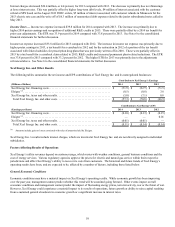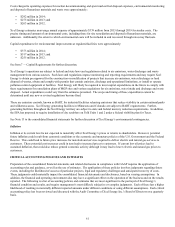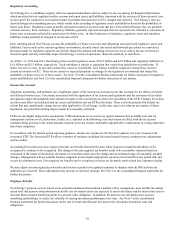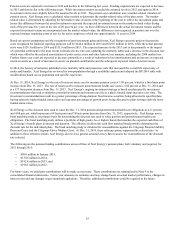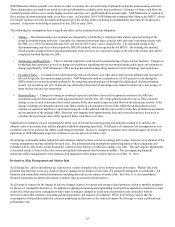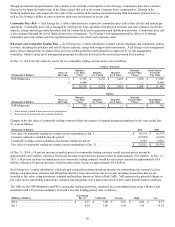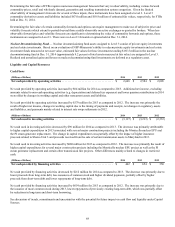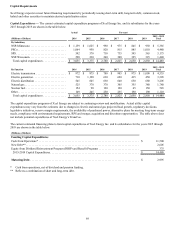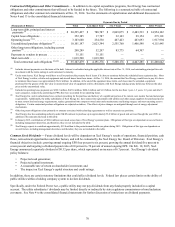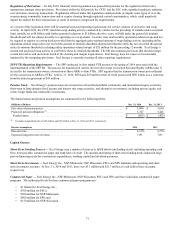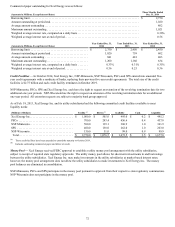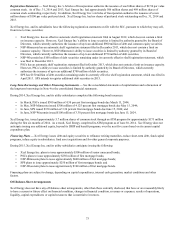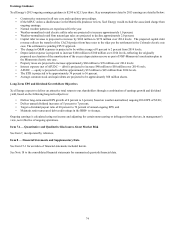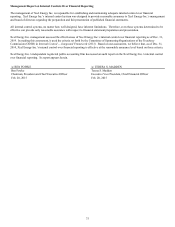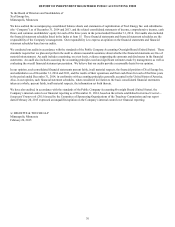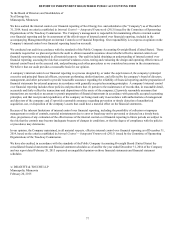Xcel Energy 2014 Annual Report Download - page 85
Download and view the complete annual report
Please find page 85 of the 2014 Xcel Energy annual report below. You can navigate through the pages in the report by either clicking on the pages listed below, or by using the keyword search tool below to find specific information within the annual report.67
Nuclear Fuel Supply — NSP-Minnesota is scheduled to take delivery of approximately 13 percent of its 2015 enriched nuclear
material requirements from sources that could be impacted by events in Ukraine and sanctions against Russia. In 2014, NSP-
Minnesota arranged for and took delivery of material from alternate sources that were not impacted by these world events. These
alternate sources are expected to provide the flexibility to manage NSP-Minnesota’s nuclear fuel supply to ensure that plant
availability and reliability will not be negatively impacted in the near-term. Long-term, through 2024, NSP-Minnesota is scheduled to
take delivery of approximately 34 percent of its average enriched nuclear material requirements from sources that could be impacted
by events in Ukraine and extended sanctions against Russia. NSP-Minnesota is closely following the progression of these events and
will periodically assess if further actions are required to assure a secure supply of enriched nuclear material beyond 2015.
Interest Rate Risk — Xcel Energy is subject to the risk of fluctuating interest rates in the normal course of business. Xcel Energy’s
risk management policy allows interest rate risk to be managed through the use of fixed rate debt, floating rate debt and interest rate
derivatives such as swaps, caps, collars and put or call options.
At Dec. 31, 2014 and 2013, a 100 basis point change in the benchmark rate on Xcel Energy’s variable rate debt would impact annual
pretax interest expense by approximately $10.4 million and $8.3 million, respectively. See Note 11 to the consolidated financial
statements for a discussion of Xcel Energy Inc. and its subsidiaries’ interest rate derivatives.
NSP-Minnesota also maintains a nuclear decommissioning fund, as required by the NRC. The nuclear decommissioning fund is
subject to interest rate risk and equity price risk. At Dec. 31, 2014, the fund was invested in a diversified portfolio of cash equivalents,
debt securities, equity securities, and other investments. These investments may be used only for activities related to nuclear
decommissioning. Given the purpose and legal restrictions on the use of nuclear decommissioning fund assets, realized and unrealized
gains on fund investments over the life of the fund are deferred as an offset of NSP-Minnesota’s regulatory asset for nuclear
decommissioning costs. Consequently, any realized and unrealized gains and losses on securities in the nuclear decommissioning
fund, including any other-than-temporary impairments, are deferred as a component of the regulatory asset for nuclear
decommissioning. Since the accounting for nuclear decommissioning recognizes that costs are recovered through rates, fluctuations in
equity prices or interest rates do not have a direct impact on earnings.
Credit Risk — Xcel Energy Inc. and its subsidiaries are also exposed to credit risk. Credit risk relates to the risk of loss resulting from
counterparties’ nonperformance on their contractual obligations. Xcel Energy Inc. and its subsidiaries maintain credit policies
intended to minimize overall credit risk and actively monitor these policies to reflect changes and scope of operations.
At Dec. 31, 2014, a 10 percent increase in commodity prices would have resulted in an increase in credit exposure of $12.2 million,
while a decrease in prices of 10 percent would have resulted in an increase in credit exposure of $2.7 million. At Dec. 31, 2013, a 10
percent increase in commodity prices would have resulted in an increase in credit exposure of $15.2 million, while a decrease in prices
of 10 percent would have resulted in an increase in credit exposure of $2.6 million.
Xcel Energy Inc. and its subsidiaries conduct standard credit reviews for all counterparties. Xcel Energy employs additional credit
risk control mechanisms when appropriate, such as letters of credit, parental guarantees, standardized master netting agreements and
termination provisions that allow for offsetting of positive and negative exposures. Credit exposure is monitored and, when necessary,
the activity with a specific counterparty is limited until credit enhancement is provided. Distress in the financial markets could
increase Xcel Energy’s credit risk.
Fair Value Measurements
Xcel Energy follows accounting and disclosure guidance on fair value measurements that contains a hierarchy for inputs used in
measuring fair value and requires disclosure of the observability of the inputs used in these measurements. See Note 11 to the
consolidated financial statements for further discussion of the fair value hierarchy and the amounts of assets and liabilities measured at
fair value that have been assigned to Level 3.
Commodity Derivatives — Xcel Energy continuously monitors the creditworthiness of the counterparties to its commodity derivative
contracts and assesses each counterparty’s ability to perform on the transactions set forth in the contracts. Given this assessment and
the typically short duration of these contracts, the impact of discounting commodity derivative assets for counterparty credit risk was
not material to the fair value of commodity derivative assets at Dec. 31, 2014. Adjustments to fair value for credit risk of commodity
trading instruments are recorded in electric revenues. Credit risk adjustments for other commodity derivative instruments are deferred
as OCI or regulatory assets and liabilities. The classification as a regulatory asset or liability is based on commission approved
regulatory recovery mechanisms. Xcel Energy also assesses the impact of its own credit risk when determining the fair value of
commodity derivative liabilities. The impact of discounting commodity derivative liabilities for credit risk was immaterial to the fair
value of commodity derivative liabilities at Dec. 31, 2014.
Commodity derivative assets and liabilities assigned to Level 3 typically consist of FTRs, as well as forwards and options that are
long-term in nature. Level 3 commodity derivative assets and liabilities represent 3.7 percent and 41.0 percent of gross assets and
liabilities, respectively, measured at fair value at Dec. 31, 2014.




